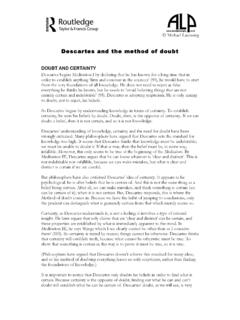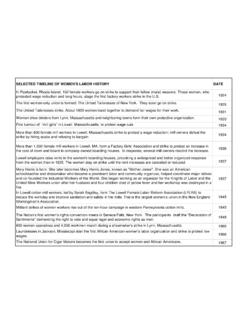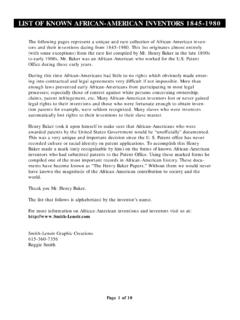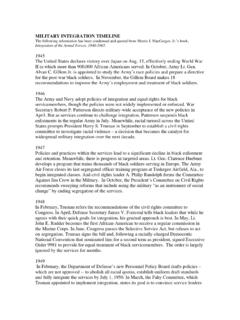Transcription of History of Racism and Immigration Time Line - Routledge
1 History OF Racism AND Immigration time line Key Events in the Struggle for Racial Equality in the United States 1790: Naturalization Act of 1790; Citizenship restricted to free Whites. 1819: Congress passes Civilization Act of 1819 to assimilate Native Americans. This law provided government funds to subsidize Protestant missionary educators in order to convert Native Americans to Christianity. 1827: Freedom s Journal, first African American newspaper appears. Cherokee Republic formed in attempt to avoid forced removal. 1830: Congress passes Indian Removal Act, legalized removal of all Indians east of Mississippi to lands west of the river. 1831 1838: Indian tribes forcibly resettled to West in Trail of Tears. As part of Andrew Jackson s Indian removal policy, the Cherokee nation was forced to give up its lands east of the Mississippi River and to migrate to an area in present-day Oklahoma.
2 The Cherokee people called this journey the Trail of Tears, because of its devastating effects. The migrants faced hunger, disease, and exhaustion on the forced march. Over 4,000 out of 15,000 of the Cherokee died. 1835 1842: Seminoles resist removal in Second Seminole War. 1845: government annexes Texas. 1846: government declares war on Mexico. 1848: defeats Mexico and purchases for $15 million over one-third of the Mexican nation. The land includes the future states of California, Texas, Utah, New Mexico, Arizona, Nevada, and parts of Colorado and Wyoming. Treaty of Guadalupe Hidalgo cedes Mexican territory in Southwest to the The treaty promises to protect the land, language, and culture of Mexicans living in the ceded territory. Mexicans are given the right to become citizens if they decide to stay. However, Congress refuses to pass Article X, which stipulated the protection of the ancestral lands of Mexican people.
3 Instead, Congress requires them to prove, in courts, speaking English, with lawyers, that they have legitimate titles to their lands. Arrival of large numbers of Chinese laborers to the West Coast to work in the mining and agricultural industry. Many of these laborers also help build the Transcontinental Railroad. 1849: The Hounds, a white vigilante group in San Francisco, attacks a Chilean mining community, raping women, burning houses, and lynching two men. 1850: The California legislature passes the Foreign Miners Tax, which requires Chinese and Latin American gold miners to pay a special tax on their holdings, a tax not required of European American miners. Congress passes the Fugitive Slave Law allowing federal marshals to capture runaway slaves and enlist the assistance of History of Racism and Immigration time line other Whites; also makes it possible for a black person to be captured as a slave solely on the sworn statement of a white person with no right to challenge the claim in court.
4 1855: California requires all instruction to be conducted in English. 1857: Dred Scott v. Sanford endorses southern views on race in the territories when Dred Scott, a slave who followed his owner to a free state, sued for his freedom. The Supreme Court ruled that Scott was still a slave. 1859: White abolitionist John Brown leads raid on Harper s Ferry arsenal to get weapons for arming slaves to resist slavery. Most of his men were killed, and he was tried for treason and hanged. 1862: President Lincoln signs Homestead Act allotting 160 acres of western land Native American land to anyone who could pay $ and cultivate it for five years. European immigrants and land speculators bought 50 million acres. Congress gave another 100 million acres of Indian land free to the railroads. Since the Homestead Act applied only to citizens, Native Americans, Blacks and non-European immigrants were excluded.
5 1863: President Lincoln issues the Emancipation Proclamation as the nation approaches the third year of bloody civil war declaring that all persons held as slaves within the rebellious states are, and henceforward shall be free. It applied only to states that had seceded from the Union, leaving slavery untouched in loyal border states; and also exempted parts of the Confederacy that had already come under Northern control. Thus the freedom it promised depended upon Union military victory. 1864: Ratification of the 13th Amendment to the Constitution abolishing slavery. The army massacres 300 Cheyenne Indians in the Sand Creek Massacre. 1866 1877: Reconstruction tried to bring Southern states back into the union and build a non-slave society with full civil rights for former slaves. Black and white teachers from the north traveled south to build schools and teach former slaves eager to become literate.
6 With the protection of the 13th, 14th, and 15th Amendments and the Civil Rights Act of 1866, African Americans participated in politics, voted, used public accommodations. The former confederates fought against reconstruction and eventually eroded newly gained rights of freedman. 1866: Congress passes Civil Rights Act of 1866. 1868: Treaty of Fort Laramie agrees that Whites will not enter Black Hills without Indian permission, but when gold is found there, the terms of treaty are changed by Congress without Indian consent. 1870: Texas law requires English as the language of school instruction. Naturalization Act of 1870 revises the Naturalization Act of 1790 and the 14th Amendment so that naturalization is limited to white persons and persons of African descent, effectively excluding Chinese and other Asian immigrants from naturalization. 1871: A white mob in Los Angeles attacks a Chinese community, killing 19 and destroying the community.
7 Congress passes Indian Appropriations Act, dissolving the status of Indian tribes as nations. 1872 1874: government permits white traders to slaughter buffalo in order to rid the Plains of Indians. By 1874, Plain Indians Cheyenne, Kiowa, and Comanche have lost control of their territory. 1875: Page Law. Congress bars entry of Chinese, Japanese, and Mongolian prostitute, felons, and contract laborers. 1876: Battle of Little Big Horn; Sioux annihilate white troops led by General Custer. Reciprocity treaty between Kingdom of Hawaii and the United States that allowed for duty-free importation of Hawaiian grown cane sugar into the This act permanently altered the Hawaiian landscape by promoting sugar plantation agriculture. 1878: Supreme Court rules Chinese individuals are ineligible for naturalized citizenship. 1880 1881: Helen Hunt Jackson s A Century of Dishonor influences public conscience about poor government treatment of Indians.
8 1882: Chinese Exclusion Act. Congress prohibits Chinese Immigration for 10 years, bowing to pressure from nativists on the West Coast, (renewed 1892, made permanent 1902, repealed 1943). 1882 1990: 3,011 recorded lynchings of African Americans primarily, but not exclusively, in the South. 1883: Supreme Court strikes down 1875 Civil Rights Act and reinforces claim that the federal government cannot regulate behavior of private individuals in matters of race relations. 1886: Apache warrior, Geronimo, surrenders to the army. His surrender marks the defeat of Southwest Indian nations. 1887: Dawes Act dissolves tribal lands, granting land allotments to individual families leading to division of Indian territory and encroachment by Whites on Indian land. This act explicitly prohibits communal land ownership. The Supreme Court decides in favor of the Maxwell Company, a division of the Santa Fe Ring, allocating millions of acres of Mexican and Indian land in New Mexico to the Anglo corporation.
9 1890: The Wounded Knee massacre by the Army marks the end of 19th-century struggle of the Plain Indians to keep their land free from Whites. The Bennett Law (Wisconsin) forbids recognition of schools teaching in languages other than English, an attack on the German-teaching Lutheran and Catholic parochial schools, removing their eligibility to satisfy the state s compulsory school attendance law. 1895: Booker T. Washington gives Atlanta Compromise speech to an all-white audience claiming that his race would content itself by living with the production of their hands. 1896: Plessy v. Ferguson upholds doctrine of separate but equal among Blacks and Whites in public facilities. 1897: In Re Ricardo Rodriguez, a federal district court in Texas narrowly upholds the right of Mexicans to naturalized citizenship under the Treaty of Guadalupe Hidalgo, holding Mexicans to be white for purposes of naturalization.
10 1898: The defeats Spain and acquires Puerto Rico, Guam, and the Philippines. The annexes Hawaii. 1900: Congress passes the Foraker Act, establishing a colonial government in Puerto Rico and stipulating both the governor and executive council be appointed by the 1901: citizenship granted to the Five Civilized Tribes Cherokee, Chocktaw, Seminole, Creek, Chickasaw. 1902: Chinese Immigration made permanently illegal; Chinese population sharply declines. 1905: DuBois, William Trotter, and others found the Niagara Movement, renouncing the accommodationist policies of Booker T. Washington in his Atlanta Compromise speech and demanding full suffrage. The Niagara Movement is the forerunner to the NAACP. 1908: Israel Zangwill s play, The Melting Pot, popularizes the term. 1909: Founding of the National Association for the Advancement of Colored People (NAACP), dedicated to ending segregation and discrimination against African Americans.



















